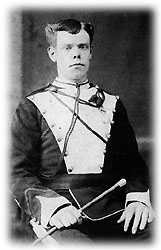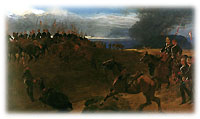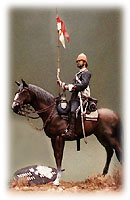|
|

| In November 1899, Miles Gissop was persuaded to give a lecture in the Morley Town Hall (complete with musical interlude) describing his experiences in the Zulu War. The manuscript of his talk, now in the possession of Mrs. Mary Travers, his granddaughter, has survived in the form of a copy made by his son from the original, and consists of some 30 closely written foolscap pages. This has been edited by David Clammer who found many mistakes and spelling errors that could have been Gissop's or his son's. Some words are in square brackets; this indicates places where a word is missing in the manuscript, or is illegible, or where a word has been inserted in order to make sense. Proper names have been corrected but most errors have been left to retain the flavour of the original. |
 |
| Miles Gissop |
The left wing was ordered to form line to the left and we did so and made a movement in line about 100 yds towards them. Halted, and waited til they were within 600 yds when they opened the most terrific fire which we stood for a minute or so when the order came to retire by column of Troops to the right. We trotted up to the square when the Infantry stepped on one side to allow us to pass into the square, the right wing of the 17th Lancers, Bullers Horse Mounted Infantry and the Native Contingent doing the same. We dismounted and the Battle commenced in down right earnest. Heavy firing was kept up for a long time when a hearty British cheer (a cheer which I shall never forget) rang out from the mouths of our Gallant British Infantry, who put their helmets on top of there Baynets spinning them as high as they could reach in the air. We knew in a second what this meant. The enemy had turned. It was at this point that my regiment had to do its cruel work. We mounted, were formed up in squadrons, rank entire [?] and charged the retreating foe, who made a Gallant stand at the bottom of a slope, but not sufficient to impede the advance of the dashing 17th. They turned again and ran as fast as there legs would carry them.
We were up to them in quick time and our Lances went through them as easy as putting them through a tub of butter. We retired slowly. The enemy having run up a hill which was too steep for us to follow. About 5000 of them squatted themselves at the top. The guns were then brought into range and poured shell amongst them scattering them in all directions, they sloped off and we saw no more of them.
 |
| After the Charge |
That shot which laid him low was unfortunate for the Zulus, for to the war-like ardour of the men who followed him was added a fierce yearning for revenge. A moment more and the bristling line of steel meets the black and shining wall of human flesh rent and pierced and gashedby a weapon as death dealing and unsparing as their own assegais, still tho' crushed and stabbed by the lances and tho' their fierce array was scattered like sea foam the Zulus fought in sullen knots nor cried for quarter stabbing at the horses bellies as they went down and trying to drag us off them in the melee. The lance was now relegated in most instances to its sling and the heavy sabres of the troops became red with gore. Sir Garnet Wolseley no doubt is a clever experienced General but he could not have moved us in a better manner nor with Greater success than did Lord Chelmsford at this memorable Battle.
 |
| Model of Trooper 1879 |
July 4th The cool manner in which the Infantry behaved whilst standing the press upon their ranks of thousands of these semi-barbarians and the half smile on their faces when (after taking steady aim) their shot took effect was amusing. Some instances of good swordsmanship were also remarkable. One officer cut a stalwart Zulu warrior completely in halves, another officer after narrowly escaping a serious assegai wound thrown with such force and precision as to go through his cloak and into the wallet of the saddle, severed the head from the hapless fellow who [threw] it.
 |
| Ceteswayo's Kraal |
We afterwards went round the Kraals and set them on fire, the Kings Kraal sharing the same fate as the rest. This kings hut was built square and much larger than the rest and was situated in the centre of the Kraals, it was lined with skins and had a mirror on the wall 24 x 18 inches & there was also an American cooking stove outside. We stood some distance from it and watched it burn to the ground. When all was over we returned to camp, the 90th Light Infantry playing "See the Conquering Heroes come, We don't want to fight" and other tunes. The men going round one to another. Fourteen killed was our loss and 61 wounded, and the estimated number of Zulus killed was 1500. I might here state that my own comrade was one of our wounded, he had two half crowns in his pocket a bullet struck one and bent it almost double and making it a wound in his side four inches long, had it not been for the 2 halfcrowns it is almost a certainty he would have lost his life. Another man who was cheering us as we left the square to charge upon the foe had a bullet sent clean through the palm of his hand.
July 5th Marched back to our late camping ground getting out of the bush and into camp about 3.0 pm when General Newdigate had us formed up in what is termed quarter column and addressed us. We commenced our homeward march and arrived at Upono River on the 19th, I don't know what people would have thought could they only have seen us with our clothes torn and patched, belts and saddles dirty, bits rusty, boots without blacking or grease, and so lamentable in appearance from the Regt which left England so clean and smart such a short time ago.
| Miles Gissop | 17th Lancers |
Armed Forces | Art and Culture | Articles | Biographies | Colonies | Discussion | Glossary | Home | Library | Links | Map Room | Sources and Media | Science and Technology | Search | Student Zone | Timelines | TV & Film | Wargames
